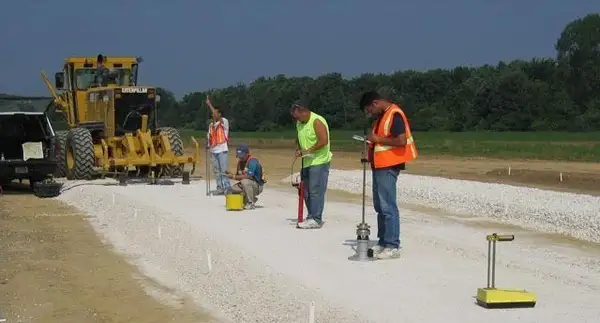Fill or Backfill Compaction Requirements for Sand, Subgrade, Sub Base, Base Course and Asphalt | Compaction Test Requirements | Field Density Test Requirements:
In this Article today we will talk about the Fill or Backfill Compaction Requirements for Soil, Subgrade, Subbase, Base Course and Asphalt Concrete | Compaction Test Requirements | Field Density Test Requirements | Compaction Specification | Proctor Compaction Test.

Fill or Backfill Compaction Requirements for Sand, Subgrade, Sub Base, Base Course and Asphalt Concrete:
- Contractor’s testing agency shall be a Client approved civil testing agency.
- One Modified Proctor Test per ASTM D1557 with corresponding Proctor curve shall be performed for each type of fill material or where there is a change in the type or the source of material.
- For cohesion-less free draining soils, ASTM D4253 Maximum Index Density and Unit Weight of Soils Using a Vibratory Table and ASTM D4254 Minimum Index Density and Unit Weight of Soil and Calculation of Relative Density shall also be performed for each type of cohesion-less, free draining material or where there is a change in the type or the source of material.
- In-place density shall be determined using one of the following:
- ASTM D-1556 Sand Cone Method;
- ASTM D-2167 Rubber Balloon Method;
- ASTM D-2922 Nuclear Method;
- or ASTM D-2937 Drive-cylinder.
- Acceptance testing of in-place density and moisture content (field density testing) on compacted fill will be performed at the following rates: 1. Under all foundations – one test every 1000 ft² (90 m²) of each lift. 2. Under area paving – one test every 2000 ft² (180 m²) of each lift. 3. Road base and sub-base – one test every 2000 ft² (180 m²) of base or sub-base. 4. Backfill of trenches – one test for every 50 linear ft (15 m) of each lift. 5. General fill – one test every 5000 ft² (460 m²) of each lift.
- As a minimum, at least one in-place density test must be performed on every lift of fill and further placement shall not be allowed until the required density has been achieved.
- Nuclear density gauges, when used, shall have a valid calibration certificate per the requirement of ASTM D2922, Sec. A1.2.

- Fill or backfill placed beneath footings, grade beams, mats, buildings or process areas shall be compacted to at least 90% of the maximum Modified Proctor density as determined by ASTM D1557.
- For cohesion-less free draining soils, 70% relative density as determined by ASTM D4253 and ASTM D4254 shall be achieved under footings, grade beams, mats, buildings or process areas. Compaction Specification
OTHER POSTS:
-
Basic Components of Road Structure and Method of Construction
-
Method Statement for Asphalt Paving Works | Asphalt Concrete
-
Asphalt Concrete Receiving, Placement and Testing Inspection | Wearing and Binder Course
-
Spread Footing or Isolated Footing Reinforcement Detail
- Under foundations with static loads over 320kPa and foundations for vibrating or heavy machinery and pavements, 85% of relative density (ASTM D4253/ASTM D4254) for cohesion-less soils or 95% of of the maximum density as determined by ASTM D1557 for cohesive materials.
- When the backfill material cannot clearly be classified as cohesive or cohesion-less both relative density and Proctor density tests must be performed. The backfill shall then be compacted to the greater density.
- The compaction requirement for base coarse (Road) shall not be less than 100% of the maximum laboratory dry density as determined by ASTM D1557 or AASHTO T180.
- The compaction requirement for subbase (Road) shall not be less than 95% of the maximum laboratory dry density as determined by ASTM D1557 or AASHTO T180.
- Unless otherwise specified, the entire subgrade (Road) shall be compacted to not less than 95% of the maximum dry density per (ASTM D1557, or AASHTO T180) while within 1.5% of the optimum moisture content or to 85% of relative density determined by ASTM D4253 and ASTM D4254. All holes, ruts, soft places, and other defects shall be corrected. In no case shall the subbase or base course be placed on soft or unstable material, or over areas that are not drained. If the subgrade is dusty or muddy, operations shall be delayed until it is in a condition satisfactory to the Saudi Aramco representative
- All other fill shall be compacted to the density equal to that shown on the drawings or equal to that adjacent in-situ material as appropriate.
- The depth of the test holes shall be no greater than 300mm (12 inches) deep. (ASTM D 2922, Sec. 1.1)
- The compaction requirements for Asphalt Concrete shall be equal to or greater than 96% of the Marshall density per ASTM D1559 using material sampled at the road site.
Conclusion:
Full article on Fill or Backfill Compaction Requirements for Soil, Subgrade, Subbase, Base Course and Asphalt Concrete | Compaction Test Requirement| Field Density Test Requirements | Compaction Specification | Proctor Compaction Test. Thank you for the full reading of this article in “The Civil Engineering” platform in English. If you find this post helpful, then help others by sharing it on social media. If you have any question regarding article please tell me in comments.


2 Comments
Very interesting! Please share for me more information regarding civil and construction engineering !
Thanks for the comments please visit more articles by clicking on “All Posts” tab of the Menu Bar